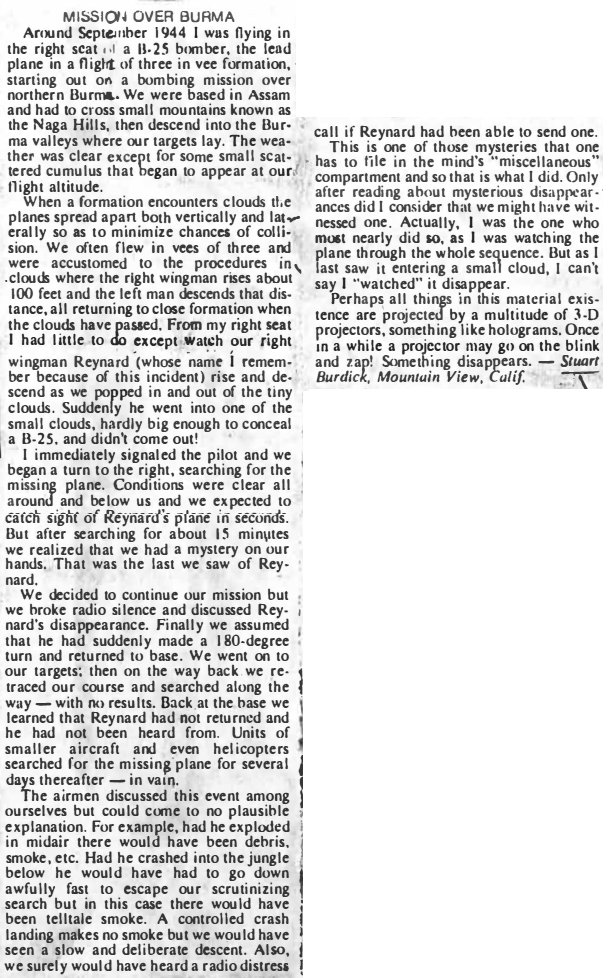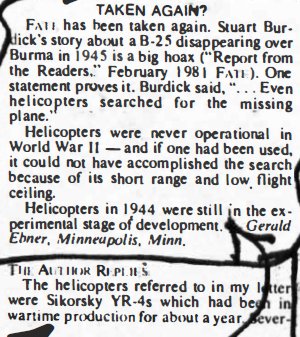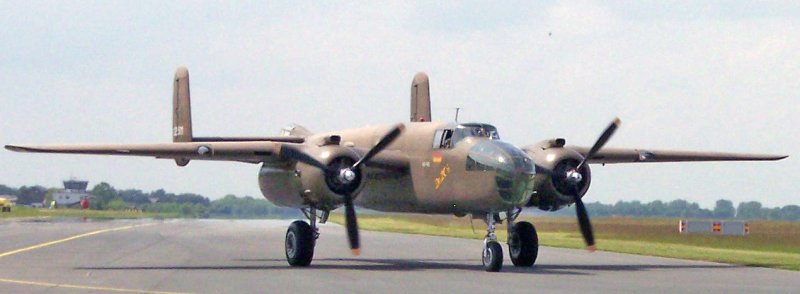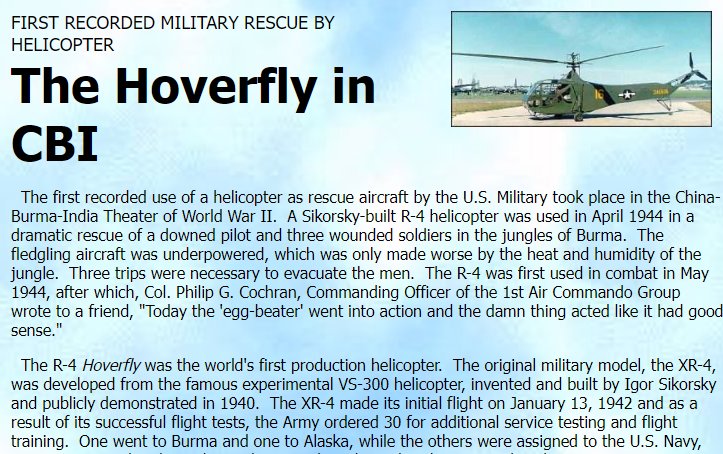ACUFO-1944-09-00-BURMA-1
The rather sensationalist American magazine FATE for February 1981 reported in its “readers' letters” a story by a one Stuart Burdick, of Mountain View, California, USA.
The latter wrote that around September 1944, he was in the right seat of a B-25 bomber, the lead plane of a flight of three planes in a V formation, beginning a bombing mission in the valleys of Northern Burma, led from Assam crossing the small mountains of Naga Hills. The weather was clear except for a few scattered small cumulus clouds which were beginning to appear at their flying altitude.
The author explains the procedure for planes in formation when they encounter clouds, which consists of moving away from each other horizontally and vertically to minimize the risk of collision. The author watched the plane to his right, piloted by a one Reynard - he remembered the name precisely because of this incident - rise and fall as the planes moved in and out of the tiny clouds. This plane on the right entered one of the small clouds, barely big enough to hide a B-25, but did not emerge from it.
The letter writer says he immediately signaled this to his pilot, and they began a right turn, searching for the missing plane, with clear conditions all around and below them; they expected to see Reynard's plane within seconds, but after about 15 minutes of searching, they realized they had a mystery on their hands.
They continued their mission, but broke the radio silence and discussed Reynard's disappearance. Eventually, they had assumed that he had suddenly made a 180 degree turn and returned to base. When they themselves returned after the mission, they followed the same route, searching without result all the way. Back at base, they learned that Reynard's plane had not returned and had given no news. Units of smaller planes and even helicopters searched for the missing plane for several days, but to no avail.
The author of the letter explains that the aviators had discussed this event among themselves but could not come to any plausible explanation: for example, if it had exploded in the air, there would have been debris, smoke, etc. If he had crashed into the jungle below, it would have had to descend very quickly to escape the painstaking search, but in this case there would have been telltale smoke. A controlled crash landing would not have produced any smoke, but they would have been able to see a slow, deliberate descent, and surely hear a radio distress call if Reynard had been able to send one.
In the following issue, another reader denounced the story as a hoax since it involved helicopters, which according to him were not yet used in operations; but in fact this objection is false, I was able to verify that as early as April 1944 there were Sikorski R-4 helicopters, in that area precisely, carrying out recovery missions in cases of crashes or forced landings of B-25s - this obviously does not prove that the story published by FATE is a real fact.
It seems that at the time of its publication, someone had tried in vain to find the author “Stuart Burdick, of Mountain View, California” in the phone book.
| Date: | September 1944 |
|---|---|
| Time: | ? |
| Duration: | N/A |
| First known report date: | 1981 |
| Reporting delay: | 4 decades. |
| Country: | Burma (Myanmar) |
|---|---|
| State/Department: | |
| City or place: |
| Number of alleged witnesses: | 2 to 16 |
|---|---|
| Number of known witnesses: | 1 |
| Number of named witnesses: | 1 |
| Reporting channel: | ? |
|---|---|
| Visibility conditions: | Clear sky with scattered small clouds. |
| UFO observed: | No. |
| UFO arrival observed: | N/A |
| UFO departure observed: | N/A |
| UFO action: | |
| Witnesses action: | Search for disappeared plane. |
| Photographs: | No. |
| Sketch(s) by witness(es): | No. |
| Sketch(es) approved by witness(es): | No. |
| Witness(es) feelings: | Puzzled. |
| Witnesses interpretation: | Mystery. |
| Sensors: |
[ ] Visual:
[ ] Airborne radar: [ ] Directional ground radar: [ ] Height finder ground radar: [ ] Photo: [ ] Film/video: [ ] EM Effects: [ ] Failures: [ ] Damages: Aircraft disappears after entering a small cloud. |
|---|---|
| Hynek: | ? |
| Armed / unarmed: | Armed, 7.62 mmm machine guns. |
| Reliability 1-3: | 1 |
| Strangeness 1-3: | 3 |
| ACUFO: | Insufficient credibility. |
[Ref. fae1:] "FATE" MAGAZINE:

|
Around September 1944 I was flying in the right seat of a B-25 bomber, the lead plane in a flight of three in vee formation, starting out on a bombing mission over northern Burma. We were based in Assam and had to cross small mountains known as the Naga Hills then descend into the Burma valleys where our targets lay. The weather was clear except for some small scattered cumulus that began to appear at our flight altitude
When a formation encounters clouds the planes spread apart both vertically and laterally so as to minimize chances of collision. We often flew in vees of three and were accustomed to the procedures clouds where the right wingman rises about 100 feet and the left man descends that distance, all returning to close formation when the clouds have passed. From my right seat I had little to do except watch our right wingman Reynard (whose name I remember because of this incident) rise and descend as we popped in and out of the tiny clouds. Suddenly he went into one of the small clouds, hardly big enough to conceal a B-25, and didn't come out!
I immediately signaled the pilot and we began a turn to the right, searching for the missing plane. Conditions were clear all around and below us and we expected to catch sight of Reynard's plane in seconds. But after searching for about 15 minutes we realized that we had a mystery on our hands. That was the last we saw of Reynard.
We decided to continue our mission but we broke radio silence and discussed Reynard's disappearance. Finally we assumed that he had suddely made a 180-degree turn and returned to base. We went on to our targets; then on the way back. we retraced our course and searched along the way - with no results. Back at the base we learned that Reynard had not returned and he had not been heard from. Units of smaller aircraft and even helicopters searched for the missing plane for several days thereafter - in vain.
The airmen discussed this event among ourselves but could come to no plausible explanation. For example, had he exploded in midair there would have been debris, smoke, etc. Had he crashed into the jungle below he would have had to go down awfully fast to escape our scrutinizing search but in this case there would have been telltale smoke. A controlled crash landing makes no smoke but we would have seen a slow and deliberate descent. Also, we surely would have heard a radio distress call if Reynard had been able to send one. This is one of those mysteries that one has to tile in the mind's “miscellaneous” compartment and so that is what I did. Only after reading about mysterious disappearances did I consider that we might have witnessed one. Actually, I was the one who most nearly did so as I was watching the plane through the whole sequence. But as I last saw it entering a small cloud, I can't say I “watched” it disappear
Perhaps, all things in this material existence are projected by a multitude of 3-D projectors, something like holograms. Once in a while a projector may go on the blink and rap! Something disappears. -- Stuart Burdick, Mountain View, Calif.
Note: a handwritten note on a copy of the article said “No one in the phone book as of 3/22/81 according to Information” an arrow pointed at the name “Stuart Burdick, Mountain View, Calif.”.
[Ref. fae1:] "FATE" MAGAZINE:

|
FATE has been taken again. Stuart Burdick's story about a B-25 disappearing over Burma in 1945 is a big hoax (“Report from the Readers.” February 1981 FATE). One statement proves it. Burdick said, “...Even helicopters searched the area for the missing plane.”
Helicopters were never operational in World War II - and if one had been used, it could not have accomplished the search because of its short range and low flight ceiling.
Helicopters in 1944 were still in the experimental stage of development.
Gerald Ebner, Minneapolis, Minn.
THE AUTHOR REPLIES
The helicopters referred to in my letter were Sikorski YR-4s which had been in wartime production for about a year. Sever-
The North American B-25 “Mitchell” (Below) was a high-performance medium bomber, used during WWII in Europe and the Pacific by the US Army Air Force.
Its crew was normally 8 men, its range was 2,170 km, its defensive armament was, depending on the versions, from 2 to 18 12.7 mm caliber machine guns.

|

|
The Sikorsky R-4 “Hoverfly”, from the American company Sikorsky Aircraft Corporation, was the first helicopter to be used by the US Army, from 1943, under the designation “Sikorsky YR-4B”.
One of his missions was precisely to locate the B-25s which had crashed in Burma, to recover their usable parts. They were also responsible for recovering the wounded.
Historical sources show that there had been Sikorskys in Burma carrying out such operations.
The first such rescue would have taken place in April 1944 (screenshot below from https://www.cbi-theater.com/hoverfly/hoverfly.html):

|
This obviously does not prove that the story was not invented. Its credibility seems rather weak to me, especially because we see that someone tried to locate the writer in the phonebook at the time and did not find him.
Insufficient credibility.
* = Source is available to me.
? = Source I am told about but could not get so far. Help needed.
| Main author: | Patrick Gross |
|---|---|
| Contributors: | None |
| Reviewers: | None |
| Editor: | Patrick Gross |
| Version: | Create/changed by: | Date: | Description: |
|---|---|---|---|
| 0.1 | Patrick Gross | October 26, 2023 | Creation, [fae1]. |
| 1.0 | Patrick Gross | October 26, 2023 | First published. |